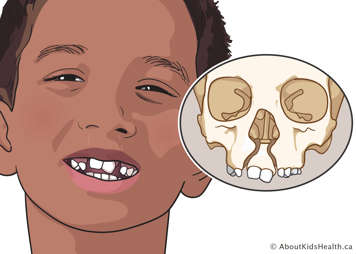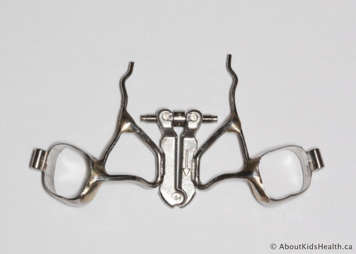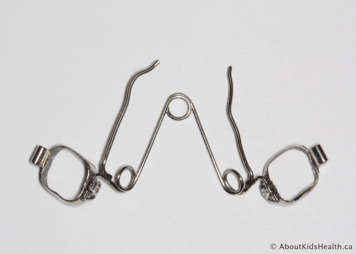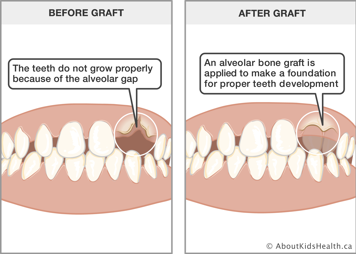

A child who has had a cleft lip and palate may also have an alveolar cleft. An alveolar cleft is a gap in the bone of the upper jaw and may occur on one side (unilateral) or on both sides (bilateral). An alveolar bone graft operation is done to close the alveolar cleft in the upper jaw. This operation is done usually when a child is between 8 and 11 years of age, typically before the upper permanent canine teeth come in. The exact timing is determined by the orthodontist.
The goals of the alveolar bone graft are to:
- Provide bone to support the teeth near the alveolar cleft
- Join the parts of the upper jaw to form a single upper dental arch
- Close any fistulas that could be present between the nose and mouth
The bone for the graft is taken from the soft bone from the inside of the top of the hip and is placed into the alveolar cleft. Once your child has recovered from the operation, they will be able to do all the activities they did before the operation.
Once your child’s adult teeth erupt into the bone graft, the orthodontist can use braces to straighten them.
Orthodontic and dental treatment before the operation
Orthodontic treatment
Your child may need orthodontic treatment before their alveolar bone graft operation. An expander is used to move the upper dental arch into a better position to make room for the alveolar bone graft. The expander is secured to the upper molar teeth where it sits behind the upper front teeth and over the palate. Treatment with the expander can take several months. The expander stays in place until the alveolar bone graft operation. Your orthodontist will tell you how to use it.


Dental extractions
Your child may need to have some teeth removed (dental extractions) before the alveolar bone graft operation. These may be baby teeth or malformed teeth that are beside the alveolar cleft. Removing these teeth gives the plastic surgeon better access and additional space to place the alveolar bone graft. The dental extractions are done six to eight weeks before the alveolar bone graft operation to allow the tissue to heal.
Unilateral alveolar bone graft: Orthodontic appliance removal, X-rays and CT scan
If your child has an expander, it will need to be removed by the orthodontist the day of the alveolar bone graft operation. Once the expander is removed, X-rays and a CT scan will also be completed on the day of the operation.
Bilateral alveolar bone graft: Orthodontic appliance removal, splint, X-rays and CT scan
If your child is having a bilateral alveolar bone graft, they will have two appointments before their operation to make a splint. The splint will be made of hard acrylic and will fit over the area of the bone graft and upper teeth. Two to three weeks before the alveolar bone graft operation, a mold will be taken of your child’s upper jaw in the Orthodontic Clinic to make the splint. One week before the operation, your child will have an appointment in the Orthodontic Clinic, where:
- The expander is removed
- X-rays are taken
- A CT scan is done
- Orthodontic buttons/braces are glued to the upper teeth
- The splint is tried on to make sure it fits
- A retainer is inserted to keep the expansion of the upper dental arch
During the operation your child’s surgeon will secure the splint to the orthodontic buttons that are glued to the upper teeth. The splint covers the alveolar bone graft to protect it. The splint will stay in your child’s mouth for eight weeks. After eight weeks the orthodontist will remove it.
Dental cleaning
Children with a cleft lip and/or palate are at higher risk for dental cavities. Your child should have a dental cleaning with fluoride application two to three weeks before the alveolar bone graft operation. This can be done by your family dentist or in the Dental Clinic at the hospital. Please talk to your orthodontist about this.
Preparing for your child’s operation
Complete a pre-anaesthesia assessment
The pre-anaesthesia assessment is usually done as a phone call. A doctor or nurse practitioner will review your child’s health issues and develop a plan for the anaesthetic for the surgery. Some children may need to meet with an anaesthesiologist in the Pre-Anaesthesia Clinic. You will be told which type of appointment your child needs.
Pack a bag for your stay
You may bring your child’s favourite toy or blanket, pajamas and clothing. Comfortable stretchy pants or shorts that will go over the hip incision are recommended. Bring a comb, soap, shampoo and other toiletry items that you and your child will need. If you plan to stay overnight with your child, you may want to bring your own sleeping bag and pillow.
Get your child ready
You play an important role in reducing your child’s risk of infection after their operation by having them bathe before their operation. Bathing reduces the number of germs that can cause an infection at the site of the operation. Your child should bathe and wash their hair with shampoo twice before their operation. The first time 48 hours before the operation and the second time 24 hours before the operation.
Follow our feeding guidelines
Your child will be given a general anaesthetic for the operation. This will help your child fall into a deep sleep so they will not feel any pain or remember the operation. Your child’s stomach must be empty before having a general anaesthetic. They must follow eating and drinking guidelines below to lessen the chance of throwing up, which could hurt their lungs.
- Your child may have solid food until midnight the night before the operation.
- Your child may have clear fluids up to three hours before the operation. Examples of clear fluids are water, clear apple juice and ginger ale, but not orange juice.
If you do not follow these feeding guidelines, your child's operation will be cancelled.
If you are unsure of these instructions, call the clinic nurse or cleft lip and palate nurse coordinator a few days before the operation.
On the day of the alveolar bone graft operation
Arrive at the hospital at least two hours before your child’s operation so you can check in. You will be asked to fill in some forms with the nurse and your child will have a final assessment before the operation.
Pre-operative bathing with pre-packaged bathing wipes
To help prevent infection, your child will have a pre-operative bath using pre-packaged wipes. Your child will be given a package of bathing wipes to bathe themselves a final time, just before their operation. A nurse will explain this to you and your child. Help your child with this if needed.
During the operation
Your child will have a general anaesthetic so that they will sleep through the operation. The anaesthetic is given in the operating room by mask or through an intravenous (IV) line inserted into the back of your child’s hand. The IV line is also used to give your child fluids and medicine.
Alveolar bone graft
To fix your child's alveolar cleft, the surgeon will take a small piece of the soft bone from the inside of the top of the hip (iliac crest). This bone will be placed in the alveolar cleft so there is no longer a hole. The area is then covered by the local surrounding tissue.

Donor site
The area of the hip where the bone is taken from is called the donor site. The operation will not damage your child’s hip, but the site will be painful for some time after the operation. At the start of the operation, the surgeon will inject local anesthetic into the donor site. This helps to decrease the amount of pain your child may experience and helps to decrease their length of stay in the hospital.
Nasoalveolar fistula
If your child has a nasoalveolar fistula (hole between the nose and the mouth), the surgeon will close this at the same time using local tissue.
Bilateral alveolar bone graft
If your child has a bilateral alveolar cleft, the surgeon will use wire to secure the splint to the orthodontic buttons that were previously glued to the teeth. This will ensure the splint remains in place for eight weeks to allow for healing.
The operation usually lasts three to four hours.

After the operation
Once the operation is complete, your child will be moved to the Post-Anaesthetic Care Unit (PACU), also called the recovery room. Your child will spend one to two hours in the PACU. You may be able to see your child for a short visit. When your child is ready, they will be moved to the Plastic Surgery Unit.
The surgeon will come to speak with you after the operation.
Visiting and staying overnight at the hospital
In general, one parent can stay overnight with their child during recovery. The parent is responsible for bringing the personal items they need during their stay with their child. If you are unsure, ask the nurse what, and what not, to bring.
Care of your child after the operation
Pain control
Your child will have pain after the operation. Your child’s surgeon or nurse will be sensitive to your concerns about your child’s pain.
After the operation, your child’s pain will be managed with a few different medications, including morphine, acetaminophen and ibuprofen. Your child may be given pain medicine every four hours, as needed. You know your child best. If you have concerns about your child's pain, speak to your child’s surgeon or nurse.
Most children complain of pain in the donor site. This pain can increase when your child spends a long time in bed, such as overnight while they are sleeping. It is important for your child to walk to the washroom before going to bed the same night after their operation. Your child will be encouraged to walk in the hallway as soon as possible, often the next morning. Pain medicine will be provided prior to going to bed (to minimize pain overnight) and prior to walking. Some children also experience pain in their mouth, which will also be managed with medication.
Eating and drinking
After the operation when your child has been moved to the Plastic Surgery Unit, they will have an IV line in place for fluids and antibiotics. The IV line will be removed when your child is drinking well and when IV antibiotics have been changed to oral (by mouth) antibiotics.
In first 24 hours after their operation, your child will initially be given clear fluids (i.e., water, broth, apple juice) and will then move to full fluids (i.e., milk, yogurt, ice cream). Once your child is tolerating fluids well, they can transition to a soft diet which they will follow for six weeks. Your child cannot have sticky foods (i.e., peanut butter) or hard foods (i.e., raw fruits or vegetables). Sharp utensils (i.e., forks and straws) that could damage the bone graft must also be avoided. Please check with your child’s surgeon or nurse if you have questions about the food your child can have and when they can have it.
Antibiotics
Your child will receive antibiotics for seven days. Your child will start on IV antibiotics and will then change to oral antibiotics for discharge.
Other things you should know about your child’s care
Swelling and position of your child in their hospital bed
Your child’s face may be puffy, particularly around the lips, cheeks and eyes. This usually lasts for five to seven days after the operation. The head of your child’s bed will be raised. This will help lessen swelling and drain fluids from your child’s mouth. This drainage may last up to 24 hours after operation. Your child will also be encouraged to move around in bed, sit up in a chair and walk to decrease the swelling.
Activity
Your child will need to get up and walk within a few hours after the operation. It may be helpful if your child is given some pain medicine before walking.
Nausea and throwing up
During the first 24 hours after the operation, your child may feel nauseous.
They may also vomit (throw up) old blood that collected in their stomach during the operation. Although this may upset you and your child, it is quite common and not usually serious. Your child will likely feel better afterwards. Your child’s nurse will help support your child if they feel nauseous and throw up. Encourage your child to rinse their mouth after vomiting.
Mouth care
Your child should rinse their mouth with water after having anything to eat or drink. This includes liquid medicines that your child receives. To help keep the incision clean, your child will also be prescribed a mouth rinse, which should be used four times a day (after breakfast, lunch, dinner and before bed). To get the full benefit of this mouth rinse, your child should not rinse their mouth with water, brush their teeth, or eat or drink any food or liquids for about 30 minutes after using it.
Teeth brushing
Unilateral alveolar bone graft
If your child had a unilateral alveolar bone graft, the lower teeth and unaffected upper teeth can be brushed, using a manual toothbrush, immediately after the operation. After two weeks, your child may gently brush the area of the operation. Supervision while your child is brushing their teeth is recommended.
Bilateral alveolar bone graft
If your child had bilateral alveolar bone grafts, they will have a splint secured over the site of the operation. This acts as a cast to allow the bone to heal and will stay in place for eight weeks. After eight weeks, it will be removed by the orthodontist.
Immediately after the operation, your child can brush their lower teeth using a manual toothbrush. After two weeks, your child may use a toothbrush to gently brush over the splint.
Do not, under any conditions, use a water flosser (i.e. Waterpik) as it will hurt the bone graft and impact healing.
Dressing
A dressing will be placed on your child's hip at the donor site. Your child’s nurse will take off the dressing the day your child goes home. Under the dressing, there will be tape (Steri-Strips) across the incision line. The tape will fall off in two weeks. If the tape does not fall off in two weeks, you may take it off.
CT scan
Your child will have a CT scan before they go home to check the bone graft.
Your child will stay in the hospital for one to three days
Once your child has recovered from the operation and you are able to take over their care, your child can go home. You will be given the instructions you need to care for your child. Any follow-up appointments will also be booked.
Discharge planning
Your child will be discharged one to three days after the operation as long as:
- Your child is drinking well
- Your child’s mouth is clean
- Your child’s pain is well managed with medicine
- Your child’s incision at their hip appears healthy and the Steri-Strips are dry and intact
- You feel comfortable providing care at home for your child
Caring for your child at home
When your child goes home from the hospital, follow these instructions:
- Your child should follow the diet your surgeon and nurse have discussed with you.
- To keep your child’s mouth clean:
- Your child should rinse their mouth with water after they eat or drink, including after taking liquid medicines.
- Your child should continue to rinse their mouth with the prescription mouth rinse. Do this for two weeks after your child is home from the hospital.
- Follow your surgeon’s instructions about teeth brushing.
- The Steri-Strips should stay on the hip incision for two weeks.
- Your child will be provided with a prescription for morphine. Use acetaminophen and ibuprofen as needed for mild pain, and morphine for moderate to severe pain.
- Limit your child’s activity for six weeks after the operation:
- Your child may not play any rough sports or any sport involving a ball, such as football, soccer, basketball or hockey.
- Your child should avoid swimming as they should not get chlorine in their mouth.
- Your child cannot take part in recess or gym.
- Your child cannot ride a bicycle.
- Your child will need to rest at home for up to two weeks after the operation.
- Check with your child’s surgeon about when your child can return to school.
Follow-up appointments
Your child will have the following follow-up appointments:
Unilateral alveolar bone graft
- Two weeks after going home, your child will have an initial follow-up appointment with their surgeon.
- Six weeks after going home, your child will have a second follow-up appointment to see the surgeon and the orthodontist.
- Six months after the operation, your child will have an appointment with the orthodontist. A CT scan will also be done to see how the bone graft has healed.
Bilateral alveolar bone graft
- Two weeks after going home, your child will have an initial follow-up appointment with their surgeon.
- Eight weeks after going home, you child will have a second follow-up appointment to see the surgeon and the orthodontist. The splint will be removed by the orthodontist.
- Six months after the operation, your child will have an appointment with the orthodontist. A CT scan will also be done to see how the bone graft has healed.
When to call the doctor
Call the cleft lip and palate nurse coordinator or your surgeon right away if you notice your child:
- Is not eating or drinking
- Has a fever
- Is bleeding from the mouth
- Has a foul odour coming from their mouth
- Has oozing, redness, swelling or pain in their hip
- Has any issues with the splint
If you have any questions, please call the cleft lip and palate nurse coordinator or the Plastic Surgery Unit at the hospital.